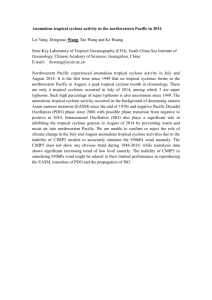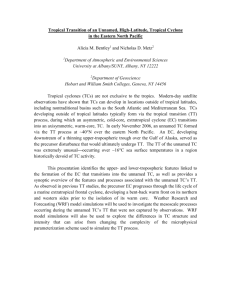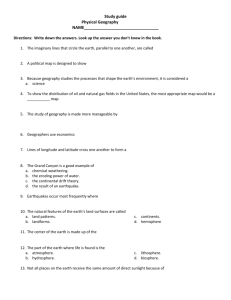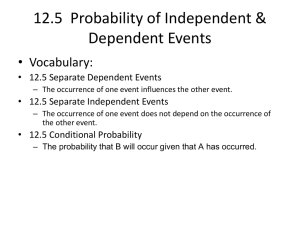Author template for journal articles
advertisement
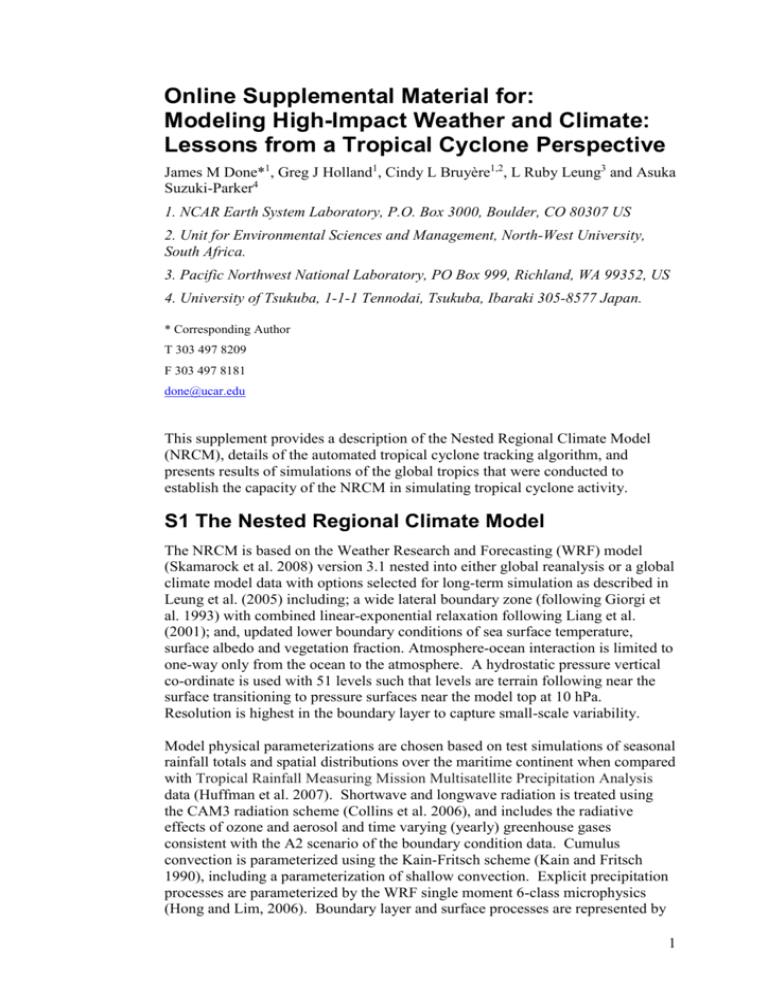
Online Supplemental Material for: Modeling High-Impact Weather and Climate: Lessons from a Tropical Cyclone Perspective James M Done*1, Greg J Holland1, Cindy L Bruyère1,2, L Ruby Leung3 and Asuka Suzuki-Parker4 1. NCAR Earth System Laboratory, P.O. Box 3000, Boulder, CO 80307 US 2. Unit for Environmental Sciences and Management, North-West University, South Africa. 3. Pacific Northwest National Laboratory, PO Box 999, Richland, WA 99352, US 4. University of Tsukuba, 1-1-1 Tennodai, Tsukuba, Ibaraki 305-8577 Japan. * Corresponding Author T 303 497 8209 F 303 497 8181 done@ucar.edu This supplement provides a description of the Nested Regional Climate Model (NRCM), details of the automated tropical cyclone tracking algorithm, and presents results of simulations of the global tropics that were conducted to establish the capacity of the NRCM in simulating tropical cyclone activity. S1 The Nested Regional Climate Model The NRCM is based on the Weather Research and Forecasting (WRF) model (Skamarock et al. 2008) version 3.1 nested into either global reanalysis or a global climate model data with options selected for long-term simulation as described in Leung et al. (2005) including; a wide lateral boundary zone (following Giorgi et al. 1993) with combined linear-exponential relaxation following Liang et al. (2001); and, updated lower boundary conditions of sea surface temperature, surface albedo and vegetation fraction. Atmosphere-ocean interaction is limited to one-way only from the ocean to the atmosphere. A hydrostatic pressure vertical co-ordinate is used with 51 levels such that levels are terrain following near the surface transitioning to pressure surfaces near the model top at 10 hPa. Resolution is highest in the boundary layer to capture small-scale variability. Model physical parameterizations are chosen based on test simulations of seasonal rainfall totals and spatial distributions over the maritime continent when compared with Tropical Rainfall Measuring Mission Multisatellite Precipitation Analysis data (Huffman et al. 2007). Shortwave and longwave radiation is treated using the CAM3 radiation scheme (Collins et al. 2006), and includes the radiative effects of ozone and aerosol and time varying (yearly) greenhouse gases consistent with the A2 scenario of the boundary condition data. Cumulus convection is parameterized using the Kain-Fritsch scheme (Kain and Fritsch 1990), including a parameterization of shallow convection. Explicit precipitation processes are parameterized by the WRF single moment 6-class microphysics (Hong and Lim, 2006). Boundary layer and surface processes are represented by 1 the non-local YSU boundary layer scheme (Hong and Pan, 1996), and the Noah land surface model (Chen and Dudhia, 2001) with 5 soil layers. S2 Automated Tropical Cyclone Tracking NRCM simulated tropical cyclones are identified and tracked automatically. Full details of the algorithm are provided in Suzuki-Parker (2012) and described briefly here. Local minima in surface pressure are first checked for 850hPa vorticity > 10-5s-1 and 10m wind speed > 17ms-1 within 1º radius of the surface pressure minima. Next, vortex structure is checked for: sum of temperature anomalies at 300-, 500- and 700-hPa > 0K; temperature anomaly at 300hPa greater than the temperature anomaly at 850hPa; and, wind speed perturbation larger at 850hPa than 300hPa. In addition, the cyclone phase parameters of Hart (2003) are checked for B (cyclone thermal symmetry) < 10, -VTL (lower tropospheric thermal wind) > 0 and –VTU (upper tropospheric thermal wind) > 0. Finally, a 2-day duration criterion is imposed. S3 Global Tropical Cyclone Activity Results are presented from simulations using NRCM configured as a tropical channel model. For this experiment the NRCM is driven by data from the NCEP/NCAR Reanalysis Project (NNRP, Kalnay et al. 1996) at 2.5° lat/lon grid spacing at the north and south lateral boundaries (45ºN and 45ºS, as shown in Fig. S1), as well as prescribed sea surface temperatures (Hurrell et al. 2008). The model is initialized on 1st January 2000 and runs though 1st January 2006 using a grid spacing of 36 km. An additional simulation is conducted with a two-way nest at 12 km grid spacing over the North Atlantic (Fig. S1) for the period 1st May 2005 through 1st Dec 2005 to probe the sensitivity of tropical cyclone simulation to model resolution. No nudging of the NRCM to NNRP data is applied in the interior of the domain. Fig. S1 NRCM model domains at 36 km grid spacing (large black box) and 12 km grid spacing (small black box). Model terrain height (shaded) is shown at the different model resolutions and extends beyond the 36 km domain to indicate the resolution of the NNRP driving data. The NRCM produces a reasonable temporal and spatial distribution of global tropical cyclone activity (Suzuki-Parker, 2012) but overproduces the total number 2 by typically 20-30% depending on the year compared to observations (using IBTrACS data, Knapp et al. 2010). This bias is in part subject to details of the tracking algorithm (Suzuki-Parker, 2012); here the algorithm is not tuned to fit a specific model grid spacing to avoid interpreting the results of tuning as model skill. Tulich et al. (2009) suggested that the bias is correlated to generally overactive easterly waves, particularly over the Northwest Pacific. Over the tropical North Atlantic, however, further examination shows that the easterly waves are generally too weak and dry, contributing to reduced tropical cyclogenesis in the eastern Tropical North Atlantic. The 12 km nested domain improves simulation of both the number and spatial distribution of tropical cyclones for the North Atlantic, with 20 storms at 12 km and 13 storms at 36 km compared to 25 tropical storms in the observations. Interestingly, at 12 km cyclogenesis occurs in the eastern tropical North Atlantic, but not at 36 km, suggesting the importance of local high resolution. Caron et al. (2010) and Caron and Jones (2011) noted a similar sensitivity of cyclogenesis in the eastern tropical North Atlantic to local resolution but found genesis to occur in this region at a grid spacing of 0.3 (approximately 30 km) rather than the higher resolution of 12 km found to be necessary in this study. This suggests local high resolution is not in itself sufficient. Cyclogenesis is influenced by large-scale, resolvable processes, (e.g. Gray 1968) but also by mesoscale processes below current model resolution. S4 Future Changes in Tropical Cyclone Frequency This section presents the non-normalized cyclone track and genesis densities as supplemental information to section 2.4 in the main manuscript. Figure S2 shows a low bias in the 36km data and a high bias in the 12km data for the base climate period. We are not too concerned about model bias in tropical cyclone frequency since frequency can easily be changed by dialing up and down thresholds in the tropical cyclone detection algorithm (Suzuki-Parker, 2012). 3 Fig. S2 Tropical cyclone track density (color shading) and genesis density (contours) for (top) IBTrACS data 1975-1995, (left column) NRCM 36 km domain, (right column) NRCM 12km domain, (top row) base climate, (middle row) the time slice 2020-2030, and, (bottom row) the time slice 2045-2055. Density is defined as the number of cyclone tracks or genesis points within a 5 degree radius of a point per year. 4 References Caron, L.-P., C.G. Jones, and K. Winger, 2010: Impact of Resolution and Downscaling Technique in Simulating Recent Atlantic Tropical Cyclone Activity. Clim. Dyn., DOI 10.1007/s00382-010-0846-7. Caron, L.-P., and C.G. Jones, 2011: Understanding and simulating the link between African Easterly Waves and Atlantic Tropical Cyclones using a Regional Climate Model: The role of domain size and lateral boundary conditions. Climate Dynamics. DOI 10.1007/s00382-011-1160-8 Chen F., and J. Dudhia, 2001: Coupling an advanced land-surface/ hydrology model with the Penn State/NCAR MM5 modeling system. Part I: model description and implementation. Mon. Wea. Rev. 129:569–585 Collins, W. D., and Coauthors, 2006: The Formulation and Atmospheric Simulation of the Community Atmosphere Model Version 3 (CAM3). J. Climate, 19, 2144–2161. Giorgi F., Marinucci M., and G. Bates 1993: Development of a second-generation regional climate model RegCM2. Part II: convective processes and assimilation of lateral boundary conditions. J. Climate 121:2814–2832 Gray, W. M., 1968: Global view of the origin of tropical disturbances and storms. Mon. Wea. Rev., 96, 669-700. Hart, R., 2003: A cyclone phase space derived from thermal wind and thermal asymmetry. Mon. Wea. Rev., 131, 585-616. Hong S.-Y., and J.-O. J. Lim, 2006: The WRF single-moment 6-class microphysics scheme (WSM6). J. Korean Meteor. Soc. 42:129–151 Hong, S. -Y. and H. -L. Pan, 1996: Nonlocal boundary layer vertical diffusion in a medium- range forecast model. Mon. Wea. Rev., 124 (10), 2322–2239. Huffman, G.J. and Coauthors, 2007: The TRMM Multi-satellite Precipitation Analysis (TMPA): Quasi-global, multiyear, combined- sensor precipitation estimates at fine scales. J. Hydrometeor., 8, 38–55. Hurrell, J., J. J. Hack, D. Shea, J. M. Caron, and J. Rosinski, 2008: A New Sea Surface Temperature and Sea Ice Boundary Dataset for the Community Atmosphere Model. J. Climate, 21, 5145-5153. Kain, J. S. and J. M. Fritsch, 1990: A one-dimensional entraining detraining plume model and its application in convective parameterization. J. Atmos. Sci., 47, 2784–2802. Liang X.-Z., Kunkel K., and A. Samel, 2001: Development of a regional climate model for U.S. Midwest applications. Part I: sensitivity to buffer zone treatment. J. Climate 14:4363–4378 Kalnay, E. et al., 1996: The NCEP/NCAR 40-year reanalysis project. Bull. Am. Meteorol. Soc., 77, 437–477. Knapp, K., M. Kruk, D. Levinson, H. Diamond, and C. Neumann, 2010: The international best track archive for climate stewardship (IBTrACS). Bull. Amer. Meteor. Soc., 91, 363-376. Leung, L. R., J. Done, J. Dudhia, T. Henderson, M. Vertenstein, and B. Kuo, 2005: Preliminary results of WRF for regional climate simulations, paper presented at Workshop on Research Needs and Directions of Regional Climate Modeling Using WRF and CCSM, National Center for Atmospheric Research, Boulder, CO. (Available at http://box.mmm.ucar.edu/events/rcm05/presentations/leung_rcm_workshop.pdf ) 5 Skamarock, W., J. Klemp, J. Dudhia, D. Gill, D. Barker, W. Wang and J. Powers, 2008: A Description of the Advanced Research WRF Version 3. NCAR Technical Note 475. 113 pp. Suzuki-Parker, A., 2012: An assessment of uncertainties and limitations in simulating tropical cyclones. Springer Thesis. XIII, 78 pp. Tulich, S., G. Kiladis, and A. Suzuki-Parker, 2009: Convectively coupled Kelvin and easterly waves in a regional climate simulation of the tropics. Clim. Dyn., doi 10.1007/s00382-009-0697-2. 6


